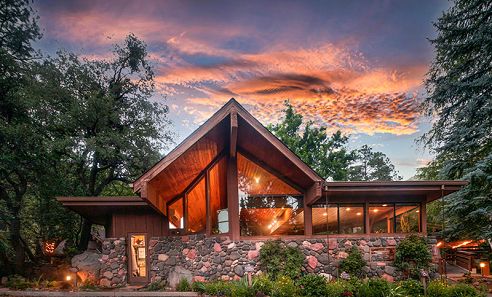
Photo Credit: David Jolkovski/Larson Newspapers
At The Table in Junipine Resort in Oak Creek Canyon, Chefs Brett Vibber and Jaren Bates celebrate Arizona Cuisine. Their menu reflects the ever-changing seasons of our state’s forests and deserts. The duo brings new meaning to foraging in the wild, as they hunt for unique flavors that are indigenous to the southwest.
While ironwood beans, pickled mallow, spruce tips, manzanita berries, sumac, barrel cactus fruit, wild morel mushrooms, fiddlehead ferns, Palo Verde seeds and ocotillo flowers may seem like inedible ingredients, these chefs found a way to create a sensory experience using unexpected discoveries in nature in their recipes.
On January 25, Chefs Vibber and Bates were selected as semifinalists in the prestigious James Beard Foundation Awards for Best Chef: Southwest [AZ, NM, NV, OK], where they competed with 19 others in the same category. They were the only chefs chosen from Sedona and the Northern Arizona region.
“The morning that we found out I’d been scouting different foraging spots in the Verde Valley. He [Jaren] was picking up corn on the reservation, so he has no reception,” Vibber said. “I'm trying to call him because our friend, Tamara texted me and said, ‘Congratulations on the nomination. You deserve it.’ I thought maybe she got the wrong Brett again. She confuses us with phone calls and texts all the time. I said, ‘Ha-ha, wrong Brett, again.’ And she texts back the [James Beard] list. I called her immediately, then Jaren, my dad and Grace [Hospitality] who manages Junipine Resort.
Vibber said that a nomination is great, however, it’s not a pinnacle for him, but it is an exciting part of their journey.
Bates was surprised about the nomination as well. He said their restaurant was only open for seven months and this was an unexpected turn of events.
“It's exciting. We weren't necessarily working towards that. We just wanted to get the restaurant open and be able to tell our story. We are finally in a setting that we were not just comfortable with, we knew that we are going to be here for quite a long time,” Bates stated.
While Bates says that he is grateful for the nomination, and to be recognized in the food world, at the end of the day, there’s work that still needs to be done.

Dish in the photo above: Sedona rainbow trout tortellini, Navajo steam corn broth, barrel cactus relish, Oak Creek watercress, dehydrated sweet corn
“We still need to show up every day and do the same job that we do, even before the nomination. Because no matter what, in the end, it's always going to come down to the food and to our story,” he said.
Bates mentioned that he is proud that the James Beard Foundation is recognizing not just Native American cuisine, but also Indigenous chefs who have been showcasing the style of food that has been around for a long time. Bates is Dine from the Navajo Reservation in Farmington, New Mexico near the Four Corners.

Dish in the photo above: Terra Farm’s Iberico pork musubi, spruce vinegar sushi rice, Junipine pickled apple and Ahi tartare
Where they met
Bates and Vibber met at Roka Akor, a trendy Japanese restaurant in Scottsdale, where they both began their careers. They opened another location of Roka Akor in Chicago and later reunited when Vibber opened Cartwright’s Modern Cuisine in Cave Creek. It was there that they found their love for Arizona cuisine, exploring ways to tell their story while preparing exquisite meals for their guests. According to these two, that is much more rewarding than being nominated as a semifinalist.

Dish in the photo above: Roasted bone marrow, caviar, pickled onion, desert seed togarashi and citrus marmalade
Vibber is an Arizona native, born and raised in Tempe, and has an immense passion for food. He attributes most of his foraging skills to growing up in the outdoors - hunting, fishing and being in the Boy Scouts. His specialty dishes are showcased by the culinary culture that he has experienced throughout his travels.
He has appeared on the first season of “Big Restaurant Bet,” where eight chefs from around the country compete for the chance to win $250,000 and partner with Geoffrey Zakarian to start the restaurant of their dreams.

Dish in the photo above: Fire-roasted beets, herbed yogurt, Navajo tea vinaigrette, garden arugula, Bell Ranch pecans
“There were six episodes, I was on five,” Vibber said. “So, I didn't win. I'm the only one that's opened a restaurant from the eight contestants since then.”
Vibber noted that he avoided the Food Network for years, turning down offers to be on Top Chef, Guy’s Grocery Games, Cutthroat Kitchen and Hell’s Kitchen.
“I've always said that I'm going to stay real and stay true to myself no matter what. If it works, it works,” Vibber said. “And now it is working. So, I didn't have to sell out or anything like that.”
Bates brings his heritage to the forefront saying that his mom was his greatest influence in the kitchen.

Dish in the photo above: Wild mushroom potsticker, chiltepin honey, juniper spiced squash broth
“I remember, it all started off with baking cakes with her as a kid … we learned how to grow crops like vegetables and produce, and learning how to live off the land and honoring it, Bates noted. “We always had a garden. After she passed, my younger brother took that upon himself to make sure we had one every year and he takes care of the family farm. In return, he provides us with the steamed corn that we have here and also certain vegetables that he plants throughout the year.”
Neeshjizhii [dried steamed corn] is a Navajo traditional food made from Indian White Corn. The process takes several days and includes harvesting the ears, layering, steaming them in an earthen pit on cedar wood coals, shucking, drying, and removing the kernels from the cobs. Bates said it is a ceremonial process that garners great rewards. It tells the story of how his ancestors harvested food and treated the land reaping a bounty of produce that lasted the season.
“I try to make it look as rustic as I can. I only want to use flavors that I remember as a kid either harvesting with my parents or grandparents or being out in the woods gathering,” Bates said. “And I think that speaks to more than just talent or skill – it shows how much love a person has not just for food, but also the culture, the planet they live on.”

Dish in the photo above: Chula seafood oysters with local yuzu
As an homage to his heritage, instinctively, Bates created a dish from steamed corn that intrigues everyone.
“I was in Durango, we made corn ice cream quite a bit during the summertime,” Bates said. “And when I started working with Brett again, I introduced him to it. We made baby corn cream for our salmon dish … it was a shoot-from-the-hip moment,” he stated. “We always knew that when we got to this point, steamed corn ice cream was going to be on the dessert menu no matter what because it was something that everybody was intrigued by when they first tried it.
The two chefs work together to create an intimate dining experience for their guests. Their menu is seasonal, and ethically sourced, while much of the produce is raised at their on-site garden.
Dishes vary from a smoked Sedona trout, tepary beans, Navajo steamed corn, squash, and wild onion chimichurri to Sonoran wheat pasta of the day, roasted chicken, Navajo winter squash and fermented garlic cream.
“We will bounce ideas off each other. One of us will create one part of the dish, and the other one will come up with another part of the dish, and then collectively, we will both come up with the main component of it and at that point, we test it,” Vibber stated. “And then at the end of the day, one of us or both of us will either take a dish and run with it or we'll both try different versions of it along the way and see which way works, but usually it's a blend of both of both of ideas come together to create a dish.”
Both Vibber and Bates love the storytelling process of their creations. They say that it’s the most important part of the process.
“While I grew up in Arizona, it was all about the story. If the story was missing, it would be like leaving a chapter out of a book,” Vibber said. “I grew up being a huge fan of storytellers - Zane Grey, Louis L’Amour, or Edward Abbey.”
Farm to Table

Dish in the photo above: Wild apple toast, date sumac caramel
Both chefs believe that fresh is best.
“When we speak publicly, I'll stop by the store and get a cucumber, a carrot, a potato and then I'll bring something that we've harvested usually that morning - a cucumber, tomato, it's got to be the exact same thing. And you'll always, always, always hear someone say, either one of two things. I haven't tasted food like this since my grandmother's garden, or I didn't know that carrots were supposed to taste this way.”
On Wednesday, March 29, the James Beard Foundation announced the finalists. While Vibber and Bates did not make the cut this year, they are grateful to be included in the prestigious list of chefs from the Southwest.

Dish in the photo above: Forager mushroom toast, pickled wild rapini, stock flowers from our garden
“I could have just come into this industry and said, ‘This is how I'm going to do food.’ I had to learn how to be a chef, how kitchens worked, how professional kitchens work - they work differently than kitchens at home, Vibber said. “But you get to a point in your career where you say, ‘I'm done learning, but I'm done learning the fundamentals. I'm done learning the basics. And I have a toolbox that's very well equipped.”

Chefs Brett Vibber and Jaren Bates, James Beard Foundation Semi-finalists. Photo Credit: David Jolkovski/Larson Newspapers
Vibber and Bates say that they love their job and the work that goes into it. For them, it’s the love of discovery, the camaraderie, the grind, the education, and the storytelling that makes them passionate about creating meals every day.
Make Your Reservation: www.junipine.com/sedona-dining
As seen in Sedona Red Rock News April 19, 2023.









